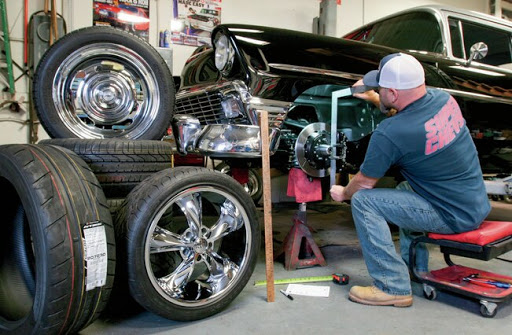
Upsizing is pretty much exactly what it sounds like: going up a tire size. Usually, this is when you take off the stock rims in favour of a larger diameter wheel (sometimes called aftermarket rims). But why do it?
To be honest, it’s mostly for looks, because there’s not a lot of performance benefits. Sometimes your braking and road holding can improve, but mostly your fuel economy will go down and your speedometer will probably be a bit off.
But, as I said, this is more about looks than performance, so if you have your eye on some 22-inch rims, here are some tips for upping your tire size:
SOME KEY FACTORS:
- Is it safe to upsize? It can be if you do it properly. The trick is going up a tire size without changing the overall diameter that much. We’ll get into it later, but it usually results in you getting a wider tire with a smaller profile (in other words, a shorter sidewall).
- Don’t forget about Clearance. This means the space between your tires and the wheel wells. This is pretty obvious while the tire is straight, but remember there are curves and bumps on the road. If you’re not careful, your tire may clear the wheel well vertically but scrape the fender liners on turns. This doesn’t mean you can’t upsize at all, just don’t go crazy on the width. Generally, you can go wider by about 10-20mm without much trouble, but more than that and you start to run into these problems.
- Ask a mechanic. As with most vehicle issues, if you’re unsure feel free to ask your mechanic! They can help you get the right size and make sure it still clears.
ON TO THE UPSIZING:
There’s a pretty easy formula you can use to make sure the overall diameter will relatively be the same. Basically, for every 1 inch added to rim diameter:
- Add 10mm to the width
- Decrease sidewall height by 5 to 10 percent
We’ll call this the “Plus 1” formula, and for it to work best, it’s a good idea to know your original diameter. It’ll not only help you understand how it really works, but it’ll let you check that your upsize is viable. So let’s talk about that before we go any further.
For example, let’s say your vehicle comes with 205-55-16 it will have a total diameter of 24.9 inches.
How do I know this?
Don’t worry, it’s not that hard. Believe me, if I can do it so can you! To figure out your diameter, you can either use a website like this (dardoor.com) or you can “math-it-out” yourself.
Here’s how to do it yourself:
- Figure out the height in mm (you can use a converter for this). In this case, the wheel height (aka the rim size) is 16 inches which come out to 406.4 mm.
- Figure out the sidewall height in mm. As we discussed here, the sidewall is actually a percentage, so this isn’t as easy as the previous step, but it’s not rocket science either. To figure this out, you’ll take the tire width and multiply it by the middle number as a percentage. So in this case it’s 205mm x 0.55 (or 55%) = 112.75mm. (205mm width x 0.55)
- Multiply the sidewall size by 2, because you have 2 sidewalls. I guess you could make sure they’re the same height and do the math all over again, but unless you have really weird tires that’s not necessary. So your combined sidewall height is 112.75 + 112.75 = 225.5 mm.
- Add all them together (the combined sidewall height and the wheel height) and you’ll have the diameter. So, for this size it’d be 225.5 + 406.4 = 631.9 mm.
- Convert that 631.9mm to inches (24.9) and you’re done! Your diameter is 24.9 inches!
So, now that you have your diameter, let’s use the “Plus 1” formula to upsize them! We’ll use the same size, 205/55/16 for this. Let’s keep it easy and say you want to move up to a 17-inch rim. You already know the rim size, so let’s figure out the rest:
- Add 10 mm to the width. So 205 becomes 215
- Decrease the sidewall percentage by 5-10. This is why it’s handy to know how to figure out the diameter. I’d recommend starting with 10% and if that works out to be a big difference, do 5% instead. So in this case 55 -10 = 45
That’s it! Your next size up should be 215/45/17. Now let’s check the diameter and make sure it works out:
- 17 inches is 431.8 mm
- Sidewall height is 215 x 0.45 = 96.75
- Combined sidewall height is 96.75 + 96.75 = 193.5
431.8 + 193.5 = 625.3 mm
So your final diameter is 625.3 mm which, according to Google, comes out to 24.6 inches, and your original tires were 24.9, so not too bad! If you want to go up more, just repeat the “Plus 1” formula for every inch you add to your rim size. If you’re really not sure about the diameter, you can use this website to compare the sizes and double-check your work. Or, as I said before, ask a mechanic if you’re really not sure.
SOME WORDS OF WARNING:
The lower your tire profile is the more careful you have to be with bumps and potholes. Remember the profile is the height of the sidewall, so the shorter that is the more likely a hard bump can pinch them. So don’t go flying over speed bumps like you’re Mad Max or you could risk damaging your tire and possibly your rim! Also, don’t mount a tire to a rim that’s wider than the recommended width for the tire for obvious reasons.
Now I don’t know about you, but that’s more math than I generally like to do in one sitting. Why not take a break and shop around in your new size?








